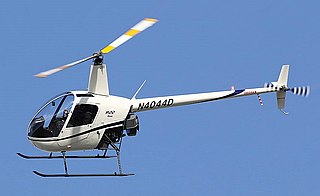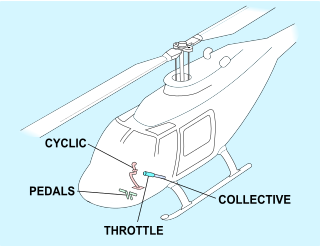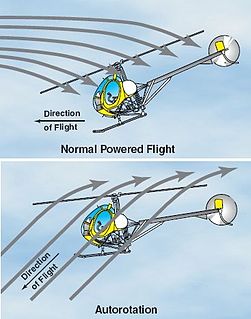
An autogyro, also known as a gyroplane or gyrocopter, is a type of rotorcraft that uses an unpowered rotor in free autorotation to develop lift. Forward thrust is provided independently, by an engine-driven propeller. While similar to a helicopter rotor in appearance, the autogyro's rotor must have air flowing across the rotor disc to generate rotation, and the air flows upwards through the rotor disc rather than down.

United Airlines Flight 232 was a regularly scheduled United Airlines flight from Stapleton International Airport in Denver to O'Hare International Airport in Chicago, continuing to Philadelphia International Airport. On July 19, 1989, the DC-10 serving the flight crash-landed at Sioux City, Iowa, after suffering a catastrophic failure of its tail-mounted engine, which led to the loss of many flight controls. Of the 296 passengers and crew on board, 112 died during the accident, while 184 people survived. The crash was the fifth-deadliest one involving the DC-10, behind Turkish Airlines Flight 981, American Airlines Flight 191, Air New Zealand Flight 901, and UTA Flight 772. Despite the deaths, the accident is considered a prime example of successful crew resource management because of the large number of survivors and the manner in which the flight crew handled the emergency and landed the airplane without conventional control.
The CarterCopter is an experimental compound autogyro developed by Carter Aviation Technologies in the United States to demonstrate slowed rotor technology. On 17 June 2005, the CarterCopter became the first rotorcraft to achieve mu-1 (μ=1), an equal ratio of airspeed to rotor tip speed, but crashed on the next flight and has been inoperable since. It is being replaced by the Carter Personal Air Vehicle.
A descent during air travel is any portion where an aircraft decreases altitude, and is the opposite of an ascent or climb.

The Robinson R22 is a two-seat, two-bladed, single-engine light utility helicopter manufactured by Robinson Helicopter Company. It was designed in 1973 by Frank Robinson, and has been in production since 1979.

The FAA states "The height–velocity diagram or H/V curve is a graph charting the safe/unsafe flight profiles relevant to a specific helicopter. As operation outside the safe area of the chart can be fatal in the event of a power or transmission failure it is sometimes referred to as the dead man's curve." The EASA refers to it as the "height/velocity avoid curve".

A helicopter pilot manipulates the helicopter flight controls to achieve and maintain controlled aerodynamic flight. Changes to the aircraft flight control system transmit mechanically to the rotor, producing aerodynamic effects on the rotor blades that make the helicopter move in a deliberate way. To tilt forward and back (pitch) or sideways (roll) requires that the controls alter the angle of attack of the main rotor blades cyclically during rotation, creating differing amounts of lift (force) at different points in the cycle. To increase or decrease overall lift requires that the controls alter the angle of attack for all blades collectively by equal amounts at the same time, resulting in ascent, descent, acceleration and deceleration.

The tail rotor is a smaller rotor mounted vertically or near-vertically at the tail of a traditional single-rotor helicopter, where it rotates to generate a horizontal thrust in the same direction as the main rotor's rotation. The tail rotor's position and distance from the helicopter's center of mass allow it to develop enough thrust leverage to counter the reactional torque exerted on the fuselage by the spinning of the main rotor. Without the tail rotor or other anti-torque mechanisms, the helicopter would be constantly spinning in the opposite direction of the main rotor when flying.

On October 14, 2004, Pinnacle Airlines Flight 3701 crashed while flying from Little Rock National Airport in Little Rock, Arkansas, United States, to Minneapolis–Saint Paul International Airport in Minnesota, United States. No passengers were aboard; both pilots were killed. Federal investigators determined the crash was due to the pilots' unprofessional behavior and disregard for training and procedures.

A gyrodyne is a type of VTOL aircraft with a helicopter rotor-like system that is driven by its engine for takeoff and landing only, and includes one or more conventional propeller or jet engines to provide forward thrust during cruising flight. During forward flight the rotor is unpowered and free-spinning, like an autogyro, and lift is provided by a combination of the rotor and conventional wings. The gyrodyne is one of a number of similar concepts which attempt to combine helicopter-like low-speed performance with conventional fixed-wing high-speeds, including tiltrotors and tiltwings.

A helicopter is a type of rotorcraft in which lift and thrust are supplied by horizontally-spinning rotors. This allows the helicopter to take off and land vertically, to hover, and to fly forward, backward and laterally. These attributes allow helicopters to be used in congested or isolated areas where fixed-wing aircraft and many forms of VTOL aircraft cannot perform.
A hard landing occurs when an aircraft or spacecraft hits the ground with a greater vertical speed and force than in a normal landing.

Autorotation is a state of flight in which the main rotor system of a helicopter or other rotary-wing aircraft turns by the action of air moving up through the rotor, as with an autogyro, rather than engine power driving the rotor. The term autorotation dates to a period of early helicopter development between 1915 and 1920, and refers to the rotors turning without the engine. It is analogous to the gliding flight of a fixed-wing aircraft.

The Helicycle is a single-seat, semi-rigid 2 bladed main rotor, helicopter powered by a Solar T62-32 engine. Manufactured by Helicycle Ventures LLC in Mesilla, New Mexico as a kit, the aircraft is intended to be assembled by the owner and is considered a homebuilt aircraft. The Helicycle was conceived and designed by B.J. Schramm, the founder of RotorWay International.

The Enstrom F-28 and 280 are a family of small, light piston engine powered helicopters produced by the Enstrom Helicopter Corporation.

A turbine engine failure occurs when a turbine engine unexpectedly stops producing power due to a malfunction other than fuel exhaustion. It often applies for aircraft, but other turbine engines can fail, like ground-based turbines used in power plants or combined diesel and gas vessels and vehicles.

Flying W Airport is a public-use airport located one nautical mile (1.852 km) southwest of the central business district of Lumberton Township in Burlington County, New Jersey, United States. The airport is privately owned. The address is 60 Fostertown Road, Medford, NJ 08055.

The Guimbal Cabri G2 is a two-seat light helicopter produced by Hélicoptères Guimbal, and powered by a reciprocating engine. Designed by Bruno Guimbal, a former Eurocopter engineer, it had its origins in the 1980s, and the first demonstrator flew in 1992. Following the granting of regulatory approval, the Cabri entered commercial service in 2008. In addition to its use within the general aviation sector and as a training rotorcraft, the Cabri G2 has also been used as the basis for unmanned aerial vehicles (UAVs).

On March 11, 2018, a sightseeing helicopter crashed into the East River off the Upper East Side of Manhattan, New York City, killing 5 people. Two passengers died at the scene, and three others were pronounced dead at the hospital. The pilot escaped the helicopter following the crash. The aircraft was operated by Liberty Helicopters for FlyNyon. Two people were from New York state; another two were from Dallas, Texas; and the fifth was from Argentina. The pilot is from Connecticut.

The 2016 Bell 525 Relentless prototype crash occurred during a test flight on July 6, 2016 near Italy, Texas, destroying the prototype Bell 525 Relentless helicopter and killing the two occupants. The helicopter broke up in flight while traveling about 229 mph (199 kn) at an altitude of about 2,000 feet (610 m); the main rotor contacted and severed the tail boom due to severe vertical oscillations. The crew were performing one engine inoperative (OEI) recovery testing; the test induced a scissors-mode vibration in the main rotor, which resulted in involuntary collective control input. The unintended biomechanical feedback loop exacerbated the vibration, until the rotor contacted the tail-boom.


















